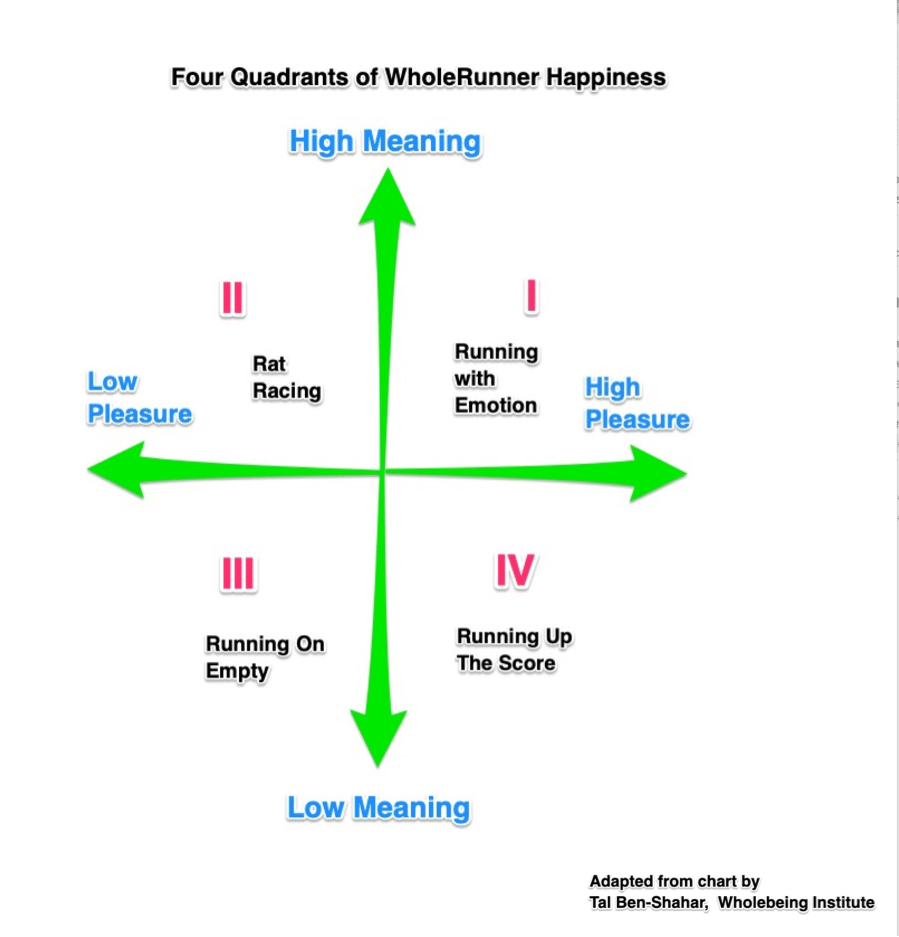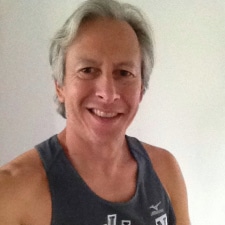by Louis Cinquino
The ways in which we decide to use our time and energy represent the most significant choices we make in our lives. No one can see our intentions—they only see what we do.
In fact, we see ourselves the same way. As we observe what we are actually doing, our view of ourselves changes. Intention may lead to action, but sometimes intentions are just ideas that don’t go anywhere. I may hold the intention to skydive someday, but until I do it, I’m not a skydiver.
Our actions are in full view for us and those around us to see and respond to. Once I start to notice and name things I’m doing that display bravery, I start to see myself as brave. We become what we do (we’ll cover this more in an upcoming post about building healthy rituals into our lives).
For now, remember our rule: You run, therefore you’re a runner. So then, why exactly do you run? Why are you a runner?
It’s a conscious choice, and a significant one. Running is time consuming, physically demanding, and keeps us from other important activities in our lives.
I’ve thought about my “why” many, many times and come up with a litany of reasons. In fact, reciting my whys became a running mantra of mine several years ago. Now, in those bitter Why the hell am I doing this? moments when I’m intensely training for an event or absolutely exhausted at the end of a long run, I remind myself of those reasons.
Some are practical (I run to become stronger), some emotional (I run for those who wish they could). They run the gamut from the playful (I run so I can wear my Spiderman tights) to the personal (I run for my Dad) to the philosophical (I run for those who have never known what it’s like to run). I can keep coming up with one reason after another for miles at a time. This puts me in an almost meditative trance—and keeps me from questioning my sanity or bowing to my fatigue. If I have this many reasons to run, I better #keepgoing.
Most of my “I run for … ” mantras are just fleeting thoughts that disappear the moment I pronounce them in my mind. But others come back to me and remain an ongoing justification for the choices that bring running back into my life over and over again.
I believe that happiness, like running, is not a singular destination but rather a way of being. When we run, we generally aren’t running somewhere in particular—or at least that’s not our purpose. I don’t run around my neighborhood just so I can arrive back where I started. I run for the running. Likewise, we don’t look for just one singular moment of happiness and try to stay there. We strive to be happy along the way, no matter where we are going or doing.
We run for the running—just like we live for the living.
Pleasure + Meaning
Tal Ben-Shahar, New York Times bestselling author of Happier, co-founder of Wholebeing Institute, and one of the primary teachers of my Certificate in Positive Psychology cohort (CiPP4), says that happiness exists at the intersection of meaning and pleasure.
“Pleasure is the more predictable and short-term physical or emotional payoff of an activity (i.e., it makes me feel good) and Meaning is considered the longer-term alignment with what you see as your life’s purpose or true calling,” he said in one of his CiPP4 lectures. “Psychology research suggests that when we can find activities that bring us both pleasure and meaning, we have found the ideal activities to have us feel happier, both immediately and over time.”
So let’s break it down. What pleasures do you run for? What immediately comes to mind? Does your list primarily consist of physical pleasures? Things like the sensations of moving your body, the way you feel when you’re done, the strength you gain, the weight you keep off, the cool shoes, the beer afterwards? Maybe it’s being outdoors in nature, seeing and conversing with other runners, the jolt running gives to your heart and lungs, the boost it gives to your immune system, or the lift it gives to your booty.
Or is your list dominated by intangibles? Does the act of running have a deeper meaning that is very personal for you? Do you feel compelled to run because it’s just part of who you are? Do you run for the people who believe in you, for the people you love? Does running help you celebrate the gifts you’ve been endowed with? Does it help you feel appreciation for being alive, so you can be stronger for the people who depend on you? Does running bring you a spiritual connection, the joy of being a part of a group, or a bridge of memory to another time in your life?
Now consider where these reasons meet—the aspects of running that simultaneously serve our awareness of pleasure and of meaning. That is where the true joys of running are unleashed.
The Four Quadrants of WholeRunner Happiness
So, let’s think about our running through this lens, with four quadrants of a graph. The horizontal axis represents pleasure and the vertical, meaning.
Quadrant IV represents running with low meaning and high pleasure. I call this Running Up The Score. The person who runs in this quadrant enjoys the act and the benefits and maybe the people they meet, but it’s basically just another form of exercise or activity that they can easily swap out with another activity that also brings them pleasure. Running is not getting them anywhere in particular.
Quadrant III: low meaning and low pleasure. I call this Running on Empty. Something is keeping this person out there, but they aren’t happy about it and it probably won’t be for long. They may be running as a response to putting on weight or because they feel they should do something to stay active. It’s like when your high school coach or gym teacher makes you run laps as a form of discipline for bad behavior. “Our sport is your punishment,” is a favorite badge-of-honor T-shirt for cross-country runners nationwide.
Quadrant II: high meaning and low pleasure. I think of this as Rat Racing. There are very specific paybacks that these runners are getting from the sport, but they basically hate it. Rat racer runners #JustDoIt, and maybe become good at it, because they are driven by a sense of purpose—like looking and feeling better, or to raise money for a good cause. Or they might have even more specific motivations, like competing with peers or being desperate to improve their health.
Quadrant I: high meaning, high pleasure. These runners get maximum benefit from their running, by appreciating the meaning behind their running as well as having awareness of the physical joys and benefits. This is what I call Running the Whole Way. I see this path as the inside track—the faster way—to happiness.
Inside Track to Happiness Exercise
Take a few minutes now to consider all the aspects of running that come to mind when you ask yourself Why do I run? Or, if it’s easier for you, What do I get out of running? I suggest doing this over a couple of days, including some days when you run. If there are different ways or situations in which you run (for example, with a group, at a specific time of day, or on a specific route), try to think about your whys during each type of run, so you get a broad picture of the place running has in your life.
Once you have a solid list, come back to the chart and plot out where each aspect of your running life seems to fit best on the pleasure/meaning scale. See which quadrant dominates your running life, and if there is variability between the whys you get from the different types of running you do.
The final step is exploring whether there are ways to derive more meaning or pleasure from each of these aspects. The biggest impact will come when you determine what it will take to move more of your running out of quadrant III and into quadrant I.
Some of us may look at the cluster of reasons in quadrant I and realize that running is more than just an exercise, or even a practice, for us—it’s a true calling, with tremendous meaning in our lives. Maybe it never even dawned on you before how important running is in your life.
That’s what happened to me when I rediscovered a deep loving of running during the breakup of my marriage at midlife. That awareness not only deepened my appreciation of my running, but also inspired me to invest more of myself in the sport—and it changed my life for the better.
With awareness, Running the Whole Way can do that for you too.
Please feel free to contact me directly or through comments if you have feedback, interest in collaborating, or ideas for me to consider as I continue to develop the WholeRunner model and program.
Watch for the next installments in Louis Cinquino’s WholeRunner series—and check out his previous posts and series for the blog here.
Louis Cinquino is a writer, Certified Distance Running Coach, life coach, dad, and graduate of CiPP4 and Positive Psychology Coaching Fundamentals. His personal observations, discoveries, and training plan as he prepared for the Fifth Avenue Mile race were featured in “The Mulligan Mile,” (Runners World, September 2013). He is currently developing WholeRunner: Your Inside Track to Happiness, a project to explore and explain the positive psychology of running. You can read more from Louis on his blog, TakingMulligans.com.



 Louis Cinquino is a writer, Certified Distance Running Coach, life coach, dad, and graduate of CiPP4 and Positive Psychology Coaching Fundamentals. His personal observations, discoveries, and training plan as he prepared for the Fifth Avenue Mile race were featured in “The Mulligan Mile,” (Runners World, September 2013). He is currently developing WholeRunner: Your Inside Track to Happiness, a project to explore and explain the positive psychology of running. You can read more from Louis on his blog,
Louis Cinquino is a writer, Certified Distance Running Coach, life coach, dad, and graduate of CiPP4 and Positive Psychology Coaching Fundamentals. His personal observations, discoveries, and training plan as he prepared for the Fifth Avenue Mile race were featured in “The Mulligan Mile,” (Runners World, September 2013). He is currently developing WholeRunner: Your Inside Track to Happiness, a project to explore and explain the positive psychology of running. You can read more from Louis on his blog, 